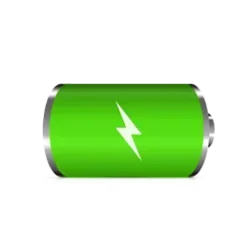This tutorial will show you how to turn on or off energy saver for all users in Windows 11.
Energy Saver replaces battery saver and exists on Windows 11 24H2 and later versions. It significantly extends battery life and reduces energy consumption by automatically managing power usage across your system and apps for an optimal balance of PC performance and energy efficiency. It can be toggled on and off or configured to run automatically whenever the device reaches a certain battery percentage. While optimized to extend battery life, energy saver will be available when PCs are plugged in (this also includes desktop PCs) for those aiming to conserve energy all the time.
Display brightness is automatically reduced up to 30% by default when using energy saver. You can specify the percentage value to scale brightness to when energy saver is turned on. You can also turn on or off Lower screen brightness when using energy saver.
Starting with build 26020 (Canary), for PCs that are plugged in and do not have batteries (such as desktop PCs), when you turn on energy saver, we are trying out a new energy saver icon that is shown in the system tray to indicate energy saver is on. For PCs with batteries, there is no change to the experience, and you will continue to see the leaf icon overlayed on top of the battery icon in the system tray.
Starting with Windows 11 build 26200.5001 (Canary), after trying out a different design for the energy saver icon in system tray a few months ago for PCs that are plugged in and do not have batteries (such as desktop PCs), Microsoft reverted the design back to the leaf icon a few builds ago. (This change is also present in Build 26100.)
Starting with Windows 11 build 26100.1882 (24H2), for laptops on battery, a notification will pop up asking you to plug in your laptop if the battery level reaches 20% while Energy Saver is set to “Always On”.
Starting with Windows 11 build 26120.3000 (Dev),
Starting with Windows 11 build 26100.4202 (24H2), Microsoft is bringing the ability to manage energy saver in Windows 11 to Microsoft Intune to allow IT administrators to control the energy saver settings on Windows 11 PCs through group policies and Mobile Device Management (MDM) configurations. The new "Enable Energy Saver to Always Be On" policy configuration can be found in Local Group Policy Editor using option 6 or 7 below.
Reference:

Energy Saver
- Option One: Turn On or Off Energy Saver in Quick Settings
- Option Two: Turn On or Off Energy Saver in Settings
- Option Three: Turn On or Off Energy Saver using REG file
- Option Four: Turn On or Off "Turn Energy Saver On Automatically" in Settings
- Option Five: Turn On or Off "Turn Energy Saver On Automatically" using Command
- Option Six: Enable or Disable Energy Saver Always Turned On in Local Group Policy Editor
- Option Seven: Enable or Disable Energy Saver Always Turned On using REG file
1 Open Quick Settings (Win+A).
2 Click/tap on the Energy saver button to toggle on or off (default). (see screenshots below)
1 Open Settings (Win+I).
2 Click/tap on System on the left side, and click/tap on Power & battery on the right side. (see screenshot below)
3 Click/tap on Energy saver to expand it open. (see screenshots below)
4 Turn On or Off (default) Always use energy saver for what you want.
5 You can now close Settings if you like.
You must be signed in as an administrator to use this option.
1 Do step 2 (on) or step 3 (off) below for what you would like to do.
(Contents of REG file for reference)
Windows Registry Editor Version 5.00
[HKEY_LOCAL_MACHINE\SYSTEM\CurrentControlSet\Control\Power]
"EnergySaverState"=dword:00000001This is the default setting
(Contents of REG file for reference)
Windows Registry Editor Version 5.00
[HKEY_LOCAL_MACHINE\SYSTEM\CurrentControlSet\Control\Power]
"EnergySaverState"=dword:000000024 Save the REG file to your desktop.
5 Double click/tap on the downloaded REG file to merge it.
6 When prompted, click/tap on Run, Yes (UAC), Yes, and OK to approve the merge.
7 Restart the computer to apply.
8 You can now delete the downloaded REG file if you like.
1 Open Settings (Win+I).
2 Click/tap on System on the left side, and click/tap on Power & battery on the right side. (see screenshot below)
3 Click/tap on Energy saver to expand it open. (see screenshot below)
4 Select Never, 10%, 20%, 30% (default), 40%, 50%, or Always for what you want in the Turn energy saver on automatically when battery level is at drop menu.
The Turn energy saver on automatically when battery level is at setting will not be available while Always use energy saver is turned on.
5 You can now close Settings if you like.
For more details on the command used in this option, see: Energy Saver settings overview
1 Open Windows Terminal, and select either Windows PowerShell or Command Prompt.
2 Type the command below into Windows Terminal, and press Enter. (see screenshot below)
powercfg /setdcvalueindex SCHEME_CURRENT SUB_ENERGYSAVER ESBATTTHRESHOLD <percentage>Substitute <percentage> in the command above with a number 0 to 100 for the percentage you want energy saver to turn on automatically at.
0 percent is the same as Never.
30 percent is the default.
100 percent is the same as Always.
For example: powercfg /setdcvalueindex SCHEME_CURRENT SUB_ENERGYSAVER ESBATTTHRESHOLD 30
You must be signed in as an administrator to use this option.
The Local Group Policy Editor is only available in the Windows 11 Pro, Enterprise, and Education editions.
All editions can use Option Seven below.
1 Open the Local Group Policy Editor (gpedit.msc).
2 Navigate to the policy location below in the left pane of the Local Group Policy Editor. (see screenshot below step 3)
3 In the right pane of Energy Saver Settings, double click/tap on the Enable Energy Saver to Always Be On policy to edit it. (see screenshot below)
4 Do step 5 (enable) or step 6 (disable) below for what you would like to do.
This will force Energy Saver to always be turned on and prevent using Option One, Option Two, Option Three, Option Four, and Option Five.
This is the default setting to allow using Option One, Option Two, Option Three, Option Four, and Option Five.
7 Close the Local Group Policy Editor.
You must be signed in as an administrator to use this option.
1 Do step 2 (enable) or step 3 (disable) below for what you would like to do.
This will force Energy Saver to always be turned on and prevent using Option One, Option Two, Option Three, Option Four, and Option Five.
(Contents of REG file for reference)
Windows Registry Editor Version 5.00
[HKEY_LOCAL_MACHINE\SOFTWARE\Policies\Microsoft\Power\EnergySaver]
"EnableEnergySaver"=dword:00000001This is the default setting to allow using Option One, Option Two, Option Three, Option Four, and Option Five.
(Contents of REG file for reference)
Windows Registry Editor Version 5.00
[HKEY_LOCAL_MACHINE\SOFTWARE\Policies\Microsoft\Power\EnergySaver]
"EnableEnergySaver"=-4 Save the REG file to your desktop.
5 Double click/tap on the downloaded REG file to merge it.
6 When prompted, click/tap on Run, Yes (UAC), Yes, and OK to approve the merge.
7 Restart the computer to apply.
8 You can now delete the downloaded REG file if you like.
That's it,
Shawn Brink











